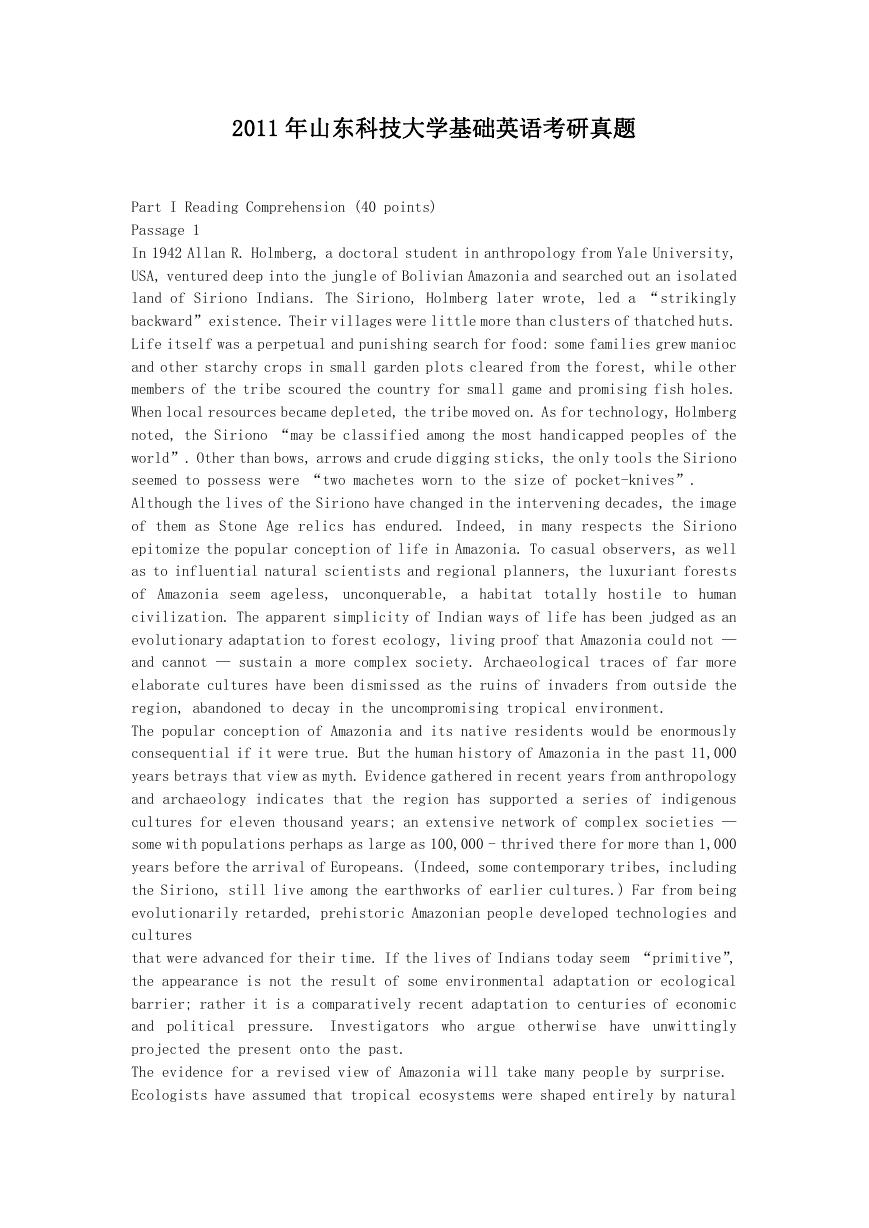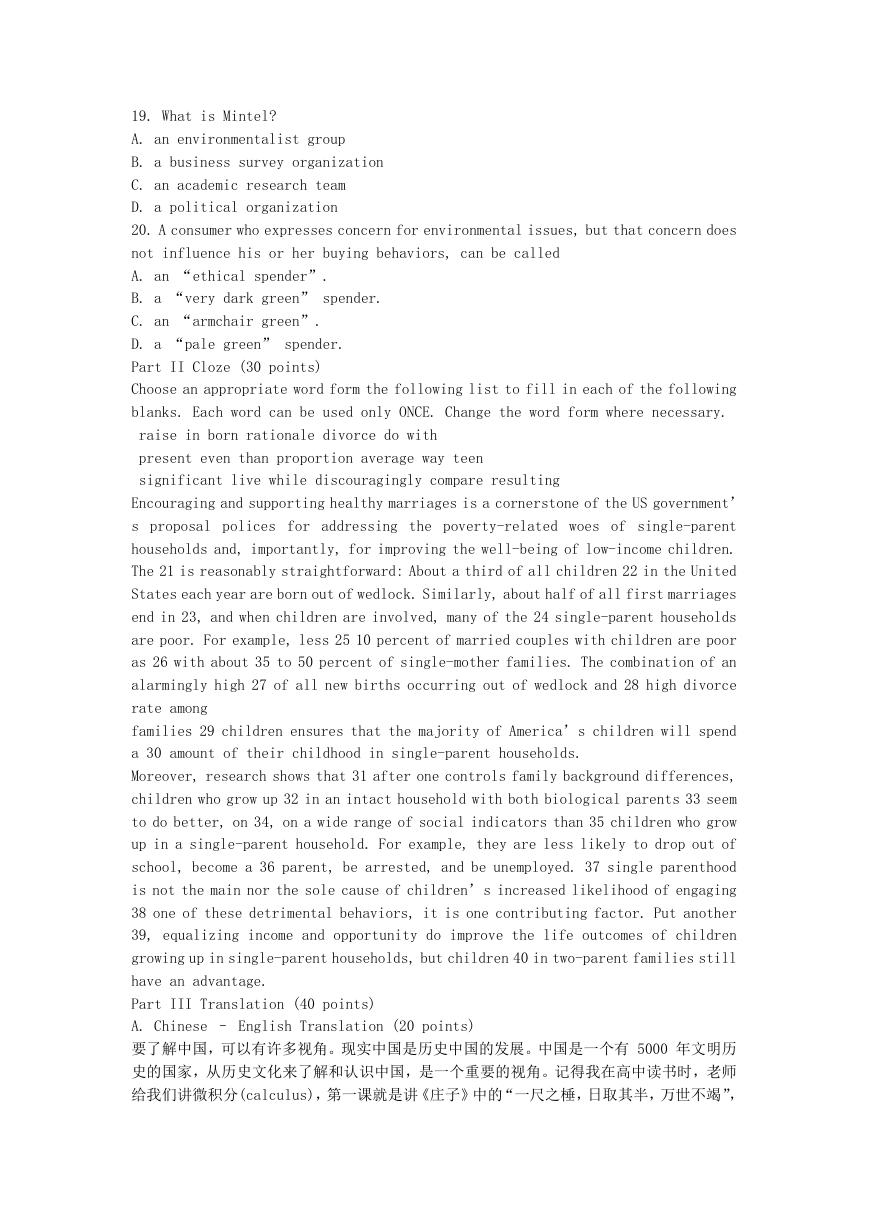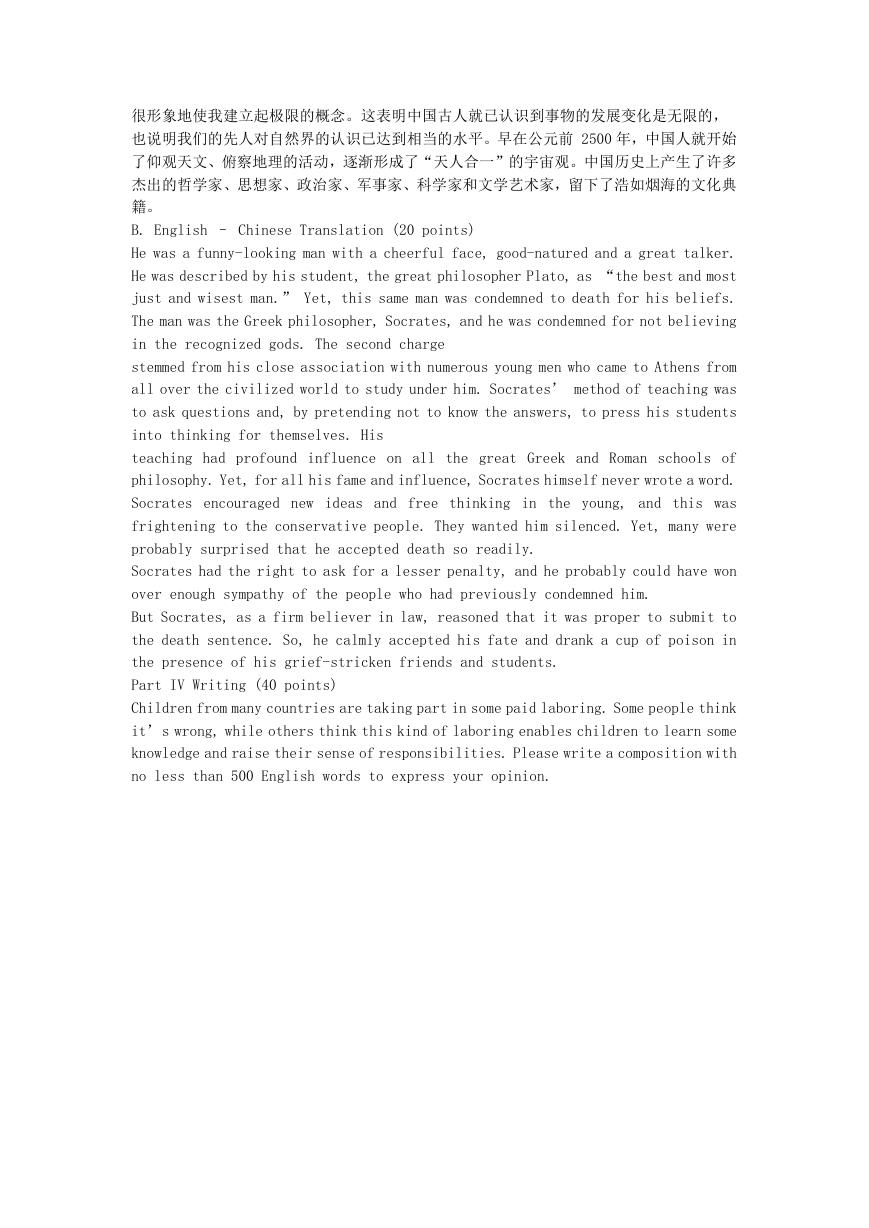2011 年山东科技大学基础英语考研真题
Part I Reading Comprehension (40 points)
Passage 1
In 1942 Allan R. Holmberg, a doctoral student in anthropology from Yale University,
USA, ventured deep into the jungle of Bolivian Amazonia and searched out an isolated
land of Siriono Indians. The Siriono, Holmberg later wrote, led a “strikingly
backward”existence. Their villages were little more than clusters of thatched huts.
Life itself was a perpetual and punishing search for food: some families grew manioc
and other starchy crops in small garden plots cleared from the forest, while other
members of the tribe scoured the country for small game and promising fish holes.
When local resources became depleted, the tribe moved on. As for technology, Holmberg
noted, the Siriono “may be classified among the most handicapped peoples of the
world”. Other than bows, arrows and crude digging sticks, the only tools the Siriono
seemed to possess were “two machetes worn to the size of pocket-knives”.
Although the lives of the Siriono have changed in the intervening decades, the image
of them as Stone Age relics has endured. Indeed, in many respects the Siriono
epitomize the popular conception of life in Amazonia. To casual observers, as well
as to influential natural scientists and regional planners, the luxuriant forests
of Amazonia seem ageless, unconquerable, a habitat totally hostile to human
civilization. The apparent simplicity of Indian ways of life has been judged as an
evolutionary adaptation to forest ecology, living proof that Amazonia could not —
and cannot — sustain a more complex society. Archaeological traces of far more
elaborate cultures have been dismissed as the ruins of invaders from outside the
region, abandoned to decay in the uncompromising tropical environment.
The popular conception of Amazonia and its native residents would be enormously
consequential if it were true. But the human history of Amazonia in the past 11,000
years betrays that view as myth. Evidence gathered in recent years from anthropology
and archaeology indicates that the region has supported a series of indigenous
cultures for eleven thousand years; an extensive network of complex societies —
some with populations perhaps as large as 100,000 - thrived there for more than 1,000
years before the arrival of Europeans. (Indeed, some contemporary tribes, including
the Siriono, still live among the earthworks of earlier cultures.) Far from being
evolutionarily retarded, prehistoric Amazonian people developed technologies and
cultures
that were advanced for their time. If the lives of Indians today seem “primitive”,
the appearance is not the result of some environmental adaptation or ecological
barrier; rather it is a comparatively recent adaptation to centuries of economic
and political pressure. Investigators who argue otherwise have unwittingly
projected the present onto the past.
The evidence for a revised view of Amazonia will take many people by surprise.
Ecologists have assumed that tropical ecosystems were shaped entirely by natural
�
forces and they have focused their research on habitats they believe have escaped
human influence. But as the University of Florida ecologist, Peter Feinsinger, has
noted, an approach that leaves people out of the equation is no longer tenable. The
archaeological evidence shows that the natural history of Amazonia is to a surprising
extent tied to the activities of its prehistoric inhabitants.
The realization comes none too soon. In June 1992 political and environmental
leaders from across the world met in Rio de Janeiro to discuss how developing
countries can advance their economies without destroying their natural resources.
The challenge is especially difficult in Amazonia. Because the tropical forest has
been depicted as ecologically unfit for large-scale human occupation, some
environmentalists have opposed development of any kind.
Ironically, one major casualty of that extreme position has been the environment
itself. While policy makers struggle to define and implement appropriate legislation,
development of the most destructive kind has continued apace over vast areas.
The other major casualty of the “naturalism” of environmental scientists has been
the indigenous Amazonians, whose habits of hunting, fishing, and slash-and-burn
cultivation often have been represented as harmful to the habitat. In the clash
between environmentalists and developers, the Indians, whose presence is in fact
crucial to the survival of the forest, have suffered the most.
The new understanding of the pre-history of Amazonia, however, points toward a middle
ground. Archaeology makes clear that with judicious management selected parts of
the region could support more people than anyone thought
before. The long-buried past, it seems, offers hope for the future.
Question: Do the following statements agree with the views of the writer in
Reading Passage 1? On your answer sheet write
YES if the statement agrees with the views of the writer
NO if the statement contradicts the views of the writer
NOT GIVEN if it is impossible to say what the writer thinks about this
1. The reason for the simplicity of the Indian way of life is that Amazonia has
always been unable to support a more complex society. ( )
2. There is a crucial popular misconception about the human history of Amazonia.
( )
3. There are lessons to be learned from similar ecosystems in other parts of the
world. ( )
4. Most ecologists were aware that the areas of Amazonia they were working in had
been shaped by human settlement. ( )
5. The indigenous Amazonian Indians are necessary to the well-being of the forest.
( )
6. It would be possible for certain parts of Amazonia to support a higher population.
( ) Multiple Choices: Choose the appropriate letters A-D.
7. In 1942 the US anthropology student concluded that the Siriono
A. were unusually aggressive and cruel.
B. had had their way of life destroyed by invaders.
C. were an extremely primitive society.
�
D. had only recently made permanent settlements.
8. The author believes recent discoveries of the remains of complex societies in
Amazonia
A. are evidence of early indigenous communities.
B. are the remains of settlements by invaders.
C. are the ruins of communities established since the European invasions.
D. show the region has only relatively recently been covered by forest
9. The assumption that the tropical ecosystem of Amazonia has been created solely
by natural forces
A. has often been questioned by ecologists in the past.
B. has been shown to be incorrect by recent research.
C. was made by Peter Feinsinger and other ecologists.
D. has led to some fruitful discoveries.
10. The application of our new insights into the Amazonian past would
A. warn us against allowing any development at all.
B. cause further suffering to the Indian communities.
C. change present policies on development in the region.
D. reduce the amount of hunting, fishing, and ‘slash-and-burn’.
Passage 2
Research in Britain has shown that “green consumers” continue to flourish as a
significant group amongst shoppers. This suggests that politicians who claim
environmentalism is yesterday’s issue may be seriously misjudging the public mood.
A report from Mintel, the market research organization, says that despite
reces
sion and financial pressures, more people than ever want to buy
environmentally friendly products and a“green wave”has swept through consumerism,
taking in people previously untouched by environmental concerns. The recently
published report also predicts that the process will repeat itself with “ethical”
concerns, involving issues such as fair trade with the Third World and the social
record of businesses. Companies will have to be more honest and open in response
to this mood.
Mintel’s survey, based on nearly 1,000 consumers, found that the proportion who
look for green products and are prepared to pay more for them has climbed from 53
per cent in 1990 to around 60 per cent in 1994. On average, they will pay 13 per
cent more for such products, although this percentage is higher among women,
managerial and professional groups and those aged 35 to 44.
Between 1990 and 1994 the proportion of consumers claiming to be unaware of or
unconcerned about green issues fell from 18 to 10 per cent but the number of green
spenders among older people and manual workers has risen substantially. Regions such
as Scotland have also caught up with the south of England in their environmental
concerns. According to Mintel, the image of green consumerism as associated in the
past with the more eccentric members of society has virtually disappeared. The
consumer research manager for Mintel, Angela Hughes, said it had become firmly
established as a mainstream market. She explained that as far as the average person
is concerned environmentalism has not “gone off the boil” . In fact, it has spread
�
green”,
across a much wider range of consumer groups, ages and occupations.
Mintel’s 1994 survey found that 13 per cent of consumers are “very dark
nearly always buying environmentally friendly products, 28 per cent are“dark green”,
trying “as far as possible” to buy such products, and 21 per cent are “pale green”
— tending to buy green products if they see them.
Another 26 per cent are “armchair greens”; they said they care about environmental
issues but their concern does not affect their spending habits.
Only 10 per cent say they do not care about green issues.
Four in ten people are “ethical spenders”, buying goods which do not, for example,
involve dealings with oppressive regimes. This figure is the same as in 1990,
although the number of “armchair ethicals” has risen from 28 to 35 per cent and
only 22 per cent say they are unconcerned now, against 30 per cent in 1990. Hughes
claims that in the twenty-first century, consumers will be en
couraged to think
more about the entire history of the products and services they buy, including the
policies of the companies that provide them and that
this will require a greater degree of honesty with consumers.
Among green consumers, animal testing is the top issue — 48 per cent said they would
be deterred from buying a product if it had been tested on animals — followed by
concerns regarding irresponsible selling, the ozone layer, river and sea pollution,
forest destruction, recycling and factory farming. However, concern for specific
issues is lower than in 1990, suggesting that many consumers feel that Government
and business have taken on the environmental agenda.
Question: Do the following statements agree with the views of the writer in Reading
Passage 2? On your answer sheet write
YES if the statement agrees with the views of the writer
NO if the statement contradicts the views of the writer
NOT GIVEN if it is impossible to say what the writer thinks about this
11. The research findings report commercial rather than political trends. ( )
12. Being financially better off has made shoppers more sensitive to buying “green”.
( )
13. The majority of shoppers are prepared to pay more for the benefit of the
environment according to the research findings. ( )
14. Consumers’ green shopping habits are influenced by Mintel’s findings. ( )
15. Mintel has limited their investigation to professional and managerial groups.
( )
16. Mintel undertakes market surveys on an annual basis. ( )
17. Nearly half of the green consumers expressed that they would not buy a product
if it had been tested on animals. ( )
Multiple Choices: Choose the appropriate letters A-D.
18. Politicians may have “misjudged the public mood” because
A. they are pre-occupied with the recession and financial problems.
B. there is more widespread interest in the environment agenda than they anticipated.
C. consumer spending has increased significantly as a result of “green” pressure.
D. shoppers are displeased with government policies on a range of issues.
�
19. What is Mintel?
A. an environmentalist group
B. a business survey organization
C. an academic research team
D. a political organization
20. A consumer who expresses concern for environmental issues, but that concern does
not influence his or her buying behaviors, can be called
A. an “ethical spender”.
B. a “very dark green” spender.
C. an “armchair green”.
D. a “pale green” spender.
Part II Cloze (30 points)
Choose an appropriate word form the following list to fill in each of the following
blanks. Each word can be used only ONCE. Change the word form where necessary.
raise in born rationale divorce do with
present even than proportion average way teen
significant live while discouragingly compare resulting
Encouraging and supporting healthy marriages is a cornerstone of the US government’
s proposal polices for addressing the poverty-related woes of single-parent
households and, importantly, for improving the well-being of low-income children.
The 21 is reasonably straightforward: About a third of all children 22 in the United
States each year are born out of wedlock. Similarly, about half of all first marriages
end in 23, and when children are involved, many of the 24 single-parent households
are poor. For example, less 25 10 percent of married couples with children are poor
as 26 with about 35 to 50 percent of single-mother families. The combination of an
alarmingly high 27 of all new births occurring out of wedlock and 28 high divorce
rate among
families 29 children ensures that the majority of America’s children will spend
a 30 amount of their childhood in single-parent households.
Moreover, research shows that 31 after one controls family background differences,
children who grow up 32 in an intact household with both biological parents 33 seem
to do better, on 34, on a wide range of social indicators than 35 children who grow
up in a single-parent household. For example, they are less likely to drop out of
school, become a 36 parent, be arrested, and be unemployed. 37 single parenthood
is not the main nor the sole cause of children’s increased likelihood of engaging
38 one of these detrimental behaviors, it is one contributing factor. Put another
39, equalizing income and opportunity do improve the life outcomes of children
growing up in single-parent households, but children 40 in two-parent families still
have an advantage.
Part III Translation (40 points)
A. Chinese – English Translation (20 points)
要了解中国,可以有许多视角。现实中国是历史中国的发展。中国是一个有 5000 年文明历
史的国家,从历史文化来了解和认识中国,是一个重要的视角。记得我在高中读书时,老师
给我们讲微积分(calculus),第一课就是讲《庄子》中的“一尺之棰,日取其半,万世不竭”,
�
很形象地使我建立起极限的概念。这表明中国古人就已认识到事物的发展变化是无限的,
也说明我们的先人对自然界的认识已达到相当的水平。早在公元前 2500 年,中国人就开始
了仰观天文、俯察地理的活动,逐渐形成了“天人合一”的宇宙观。中国历史上产生了许多
杰出的哲学家、思想家、政治家、军事家、科学家和文学艺术家,留下了浩如烟海的文化典
籍。
B. English – Chinese Translation (20 points)
He was a funny-looking man with a cheerful face, good-natured and a great talker.
He was described by his student, the great philosopher Plato, as “the best and most
just and wisest man.” Yet, this same man was condemned to death for his beliefs.
The man was the Greek philosopher, Socrates, and he was condemned for not believing
in the recognized gods. The second charge
stemmed from his close association with numerous young men who came to Athens from
all over the civilized world to study under him. Socrates’ method of teaching was
to ask questions and, by pretending not to know the answers, to press his students
into thinking for themselves. His
teaching had profound influence on all the great Greek and Roman schools of
philosophy. Yet, for all his fame and influence, Socrates himself never wrote a word.
Socrates encouraged new ideas and free thinking in the young, and this was
frightening to the conservative people. They wanted him silenced. Yet, many were
probably surprised that he accepted death so readily.
Socrates had the right to ask for a lesser penalty, and he probably could have won
over enough sympathy of the people who had previously condemned him.
But Socrates, as a firm believer in law, reasoned that it was proper to submit to
the death sentence. So, he calmly accepted his fate and drank a cup of poison in
the presence of his grief-stricken friends and students.
Part IV Writing (40 points)
Children from many countries are taking part in some paid laboring. Some people think
it’s wrong, while others think this kind of laboring enables children to learn some
knowledge and raise their sense of responsibilities. Please write a composition with
no less than 500 English words to express your opinion.
�












 2023年江西萍乡中考道德与法治真题及答案.doc
2023年江西萍乡中考道德与法治真题及答案.doc 2012年重庆南川中考生物真题及答案.doc
2012年重庆南川中考生物真题及答案.doc 2013年江西师范大学地理学综合及文艺理论基础考研真题.doc
2013年江西师范大学地理学综合及文艺理论基础考研真题.doc 2020年四川甘孜小升初语文真题及答案I卷.doc
2020年四川甘孜小升初语文真题及答案I卷.doc 2020年注册岩土工程师专业基础考试真题及答案.doc
2020年注册岩土工程师专业基础考试真题及答案.doc 2023-2024学年福建省厦门市九年级上学期数学月考试题及答案.doc
2023-2024学年福建省厦门市九年级上学期数学月考试题及答案.doc 2021-2022学年辽宁省沈阳市大东区九年级上学期语文期末试题及答案.doc
2021-2022学年辽宁省沈阳市大东区九年级上学期语文期末试题及答案.doc 2022-2023学年北京东城区初三第一学期物理期末试卷及答案.doc
2022-2023学年北京东城区初三第一学期物理期末试卷及答案.doc 2018上半年江西教师资格初中地理学科知识与教学能力真题及答案.doc
2018上半年江西教师资格初中地理学科知识与教学能力真题及答案.doc 2012年河北国家公务员申论考试真题及答案-省级.doc
2012年河北国家公务员申论考试真题及答案-省级.doc 2020-2021学年江苏省扬州市江都区邵樊片九年级上学期数学第一次质量检测试题及答案.doc
2020-2021学年江苏省扬州市江都区邵樊片九年级上学期数学第一次质量检测试题及答案.doc 2022下半年黑龙江教师资格证中学综合素质真题及答案.doc
2022下半年黑龙江教师资格证中学综合素质真题及答案.doc